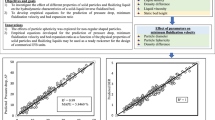Abstract
In the present study the hydrodynamic characteristics (bed expansion and pressure drop) of low-density polyethylene (LDPE) and polypropylene (PP) are studied in a liquid-solid inverse fluidized bed reactor as a function of particle diameter, liquid viscosity and density. The bed expansion and pressure drop data are used to determine the minimum fluidization velocity, U mf and friction factor, ƒ. It was found that the U mf increased with an increase in the particle diameter and a decrease in solid density and was independent of initial bed height (solid loading). In addition, the U mf decreased with an increase in the CMC concentration. The friction factor Reynolds number plot was found similar to that of classical fluidization. Dimensionless equations were proposed for the. prediction of the friction factor and the U mf.
Similar content being viewed by others
Author information
Authors and Affiliations
Additional information
Received: 17 May 1999
Rights and permissions
About this article
Cite this article
Vijaya Lakshmi, A., Balamurugan, M., Sivakumar, M. et al. Minimum fluidization velocity and friction factor in a liquid-solid inverse fluidized bed reactor. Bioprocess Engineering 22, 461–466 (2000). https://doi.org/10.1007/s004490050759
Issue Date:
DOI: https://doi.org/10.1007/s004490050759




